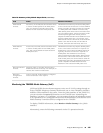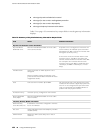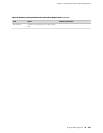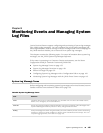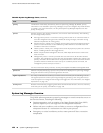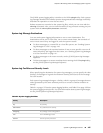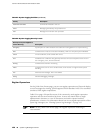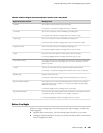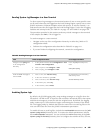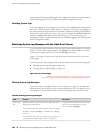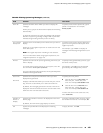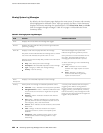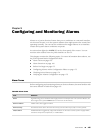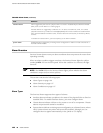
Table 83: Common Regular Expression Operators and the Terms They Match
Matching TermsRegular Expression Operator
One instance of any character except the space.
For example, .in matches messages with win or windows.
. (period)
Zero or more instances of the immediately preceding term.
For example, tre* matches messages with tree, tread or trough.
* (asterisk)
One or more instances of the immediately preceding term.
For example, tre+ matches messages with tree or tread but not trough.
+ (plus sign)
Zero or one instance of the immediately preceding term.
For example, colou?r matches messages with or color or colour.
? (question mark)
One of the terms that appear on either side of the pipe operator.
For example, gre|ay matches messages with either grey or gray.
| (pipe)
Any string except the one specified by the expression, when the exclamation
point appears at the start of the expression. Use of the exclamation point is
specific to JUNOS.
! (exclamation point)
The start of a line, when the caret appears outside square brackets.
For example, ^T matches messages with This line and not with On this line.
^ (caret)
Strings at the end of a line.
For example, :$ matches messages with the following: and not with 2:00.
$ (dollar sign)
One instance of one of the enclosed alphanumeric characters. To indicate a
range of characters, use a hyphen (-) to separate the beginning and ending
characters of the range.
For example, [0-9] matches messages with any number.
[] (paired square brackets)
One instance of the evaluated value of the enclosed term. Parentheses are used
to indicate the order of evaluation in the regular expression.
For example, dev(/|ice) matches messages with dev/ or device.
() (paired parentheses)
Before You Begin
Before you begin configuring and monitoring system log messages, complete the
following tasks:
■ Establish basic connectivity. See the Getting Started Guide for your router.
■ Configure network interfaces. See the J-series Services Router Basic LAN and WAN
Access Configuration Guide.
Before You Begin ■ 159
Chapter 8: Monitoring Events and Managing System Log Files



